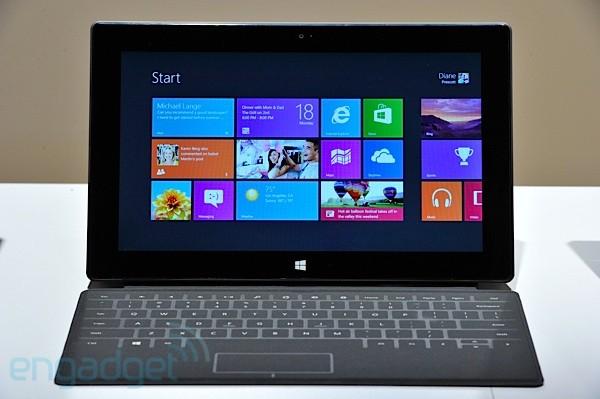
Since long before the announcement of the original iPad, tablets have been a relatively tough sale for retailers. When working for an electronics retailer, I constantly met consumers who would ask, "Why should I fork over $500 for a device that doesn't do as much as a computer for the same price?" A fair question, no doubt. Aside from portability, battery life and a seemingly endless supply of time-wasting games, it's a difficult one to answer.
And if those three things weren't at the top of that particular customer's list of priorities, that was generally the end of the conversation. "I don't think I need a tablet," they would say as they drifted off into another department or towards a clunky laptop. While tablet adoption is on a steady rise, there is also an increasing number of people realizing just how much of a supplementary device tablets are. Many may carry iPads with them everywhere they go on any given day. But chances are, at some point throughout the day, they also flip on a computer and take care of what they couldn't from their iPad.
Enter Microsoft Surface.
Around the middle of last month, Microsoft unveiled Surface at an even in Los Angeles, California. Throughout the announcement, there were two versions of Surface introduced: and ARM-based Windows RT version housing an NVIDIA Tegra processor and an Intel Core-powered Windows 8 Pro tablet. The Windows RT version will be 9.3mm, will come with either 32GB or 64GB of built-in flash storage and will feature a ClearType HD Display. It will also house an arsenal of ports, such as microSD, USB 2.0 and micro HD video. Because not all Windows software will be compatible with RT tablets, the Pro slates pack a larger punch. They will be 13.5mm thick, feature the same ClearType HD Display and either 64GB or 128GB of built-in storage. With the additional size also comes more ports and connectivity, such as: USB 3.0, microSDXC card slot and Mini DisplayPort for video.
Microsoft's endgame with Windows RT here is to undercut the competition by offering a similar product with noticeably more functionality – at least as far as productivity software goes. And with Surface for Windows Pro they are offering the full power of a PC in a slightly more robust tablet form factor. Availability of Windows RT tablets is expected around the launch of Windows 8, while Windows Pro should follow about 90 days later.
Arguably the most important detail of all, however, was not unveiled: price. In the official Surface press release, Microsoft noted pricing on Surface for Windows RT is expected to be "competitive with a comparable ARM tablet." And Surface for Windows Pro should be around that of an Ultrabook. But that's not the only time we've heard Surface will be priced competitively.
Yesterday, though, it was discovered by WPCentral that Swedish website Webhallen has four Surface models listed: Surface for Windows RT 32GB, Surface for Windows RT 64GB, Surface for Windows Pro 64GB and Surface for Windows Pro 128GB. The pricing for those models are 6990 kr, 9990 kr, 12990 kr and 14990 kr, respectively. When converting Swedish Krona to USD, the lower-end model Win RT tablet is $1,019.63 while the upper-end is $2,186.58.
Ouch.
Let's just get this out there. If the Surface base model for RT is over $1,000, Surface is destined to fail. It's DOA. And the same for the Pro versions if they're set to release around $2,100. I would just splurge the extra $300 and get a MacBook Pro with a Retina Display. I know plenty of other people who would, too, for that price.
Granted, you're going to get a lot more functionality out of Windows 8, whether it be RT or Pro, than you would out of any iPad or Android tablet. Plain and simple. But that doesn't justify being double the price it should be.
Now, do I think Surface will be priced starting at $1,000? No. I call malarky. Webhallen likely doesn't know price any more than we do right now and they're playing it safe by overpricing the units before they actually go on sale. (It's better to over estimate the price and cut it back once official pricing is announced than the other way around.) But that doesn't mean price isn't important or that Microsoft isn't fully capable of missing the mark. Surface should land around $500-$600 dollars, else a large chunk of the market will ignore the Windows tablets for something that appears more flexible, reliable and wallet-friendly (i.e.: Nexus 7, Kindle Fires and even older model iPads).
And if nothing else, if they struggle to meet that golden mark, they should throw caution to the wind and take a page from Amazon's or Google's book. Shave off profits. But instead of doing it to make money in the long term from a digital content store like the other two, Microsoft will be trading profits for market and mind share – which are worth their weight in gold nowadays – and, ultimately, to kick Apple in the back of the knees.
If the price is right, I'll be lining up to buy a Surface tablet (RT, of course) on launch day. If it's a penny over $600 for the base model (not including tax), however, I will gladly pass. What say you, folks? Does Microsoft have your attention with Surface? If so, what's the golden number for you? At what price would you say no to Surface? Would you pay $1,000 for a base model RT? $2,100 for the best Surface Microsoft has to offer?
Image via Engadget